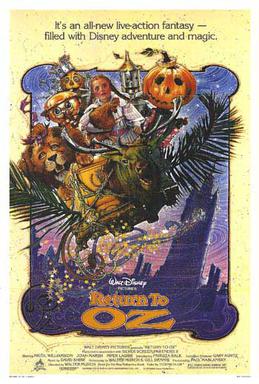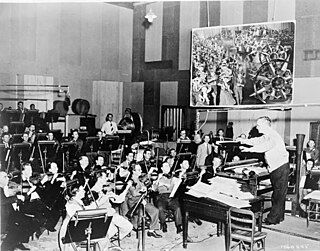
Lyman Frank Baum was an American author best known for his children's fantasy books, particularly The Wonderful Wizard of Oz, part of a series. In addition to the 14 Oz books, Baum penned 41 other novels, 83 short stories, over 200 poems, and at least 42 scripts. He made numerous attempts to bring his works to the stage and screen; the 1939 adaptation of the first Oz book became a landmark of 20th-century cinema.

The Wonderful Wizard of Oz is a 1900 children's novel written by author L. Frank Baum and illustrated by W. W. Denslow. It is the first novel in the Oz series of books. A Kansas farm girl named Dorothy ends up in the magical Land of Oz after she and her pet dog Toto are swept away from their home by a cyclone. Upon her arrival in the magical world of Oz, she learns she cannot return home until she has destroyed the Wicked Witch of the West.

Casablanca is a 1942 American romantic drama film directed by Michael Curtiz and starring Humphrey Bogart, Ingrid Bergman, and Paul Henreid. Filmed and set during World War II, it focuses on an American expatriate (Bogart) who must choose between his love for a woman (Bergman) and helping her husband (Henreid), a Czechoslovak resistance leader, escape from the Vichy-controlled city of Casablanca to continue his fight against the Germans. The screenplay is based on Everybody Comes to Rick's, an unproduced stage play by Murray Burnett and Joan Alison. The supporting cast features Claude Rains, Conrad Veidt, Sydney Greenstreet, Peter Lorre, and Dooley Wilson.

Francis Phillip Wuppermann, known professionally as Frank Morgan, was an American character actor. He was best known for his appearances in films starting in the silent era in 1916, and then numerous sound films throughout the 1930s and 1940s, with a career spanning 35 years mostly as a contract player at Metro-Goldwyn-Mayer, with his most celebrated performance playing the title role of The Wizard in the MGM movie The Wizard of Oz (1939). He was also briefly billed early in his career as Frank Wupperman and Francis Morgan.

Raymond Wallace Bolger was an American actor, dancer, singer, vaudevillian, and stage performer who started his movie career in the silent-film era.

The ruby slippers are a pair of shoes worn by Dorothy Gale as played by Judy Garland in the 1939 Metro-Goldwyn-Mayer musical film The Wizard of Oz. Because of their iconic stature, they are among the most valuable items of film memorabilia. A number of pairs were made for the film, though the exact number is unknown. Five pairs are known to have survived; one pair was stolen from a museum in 2005 and recovered in 2018.

The Wizard of Oz is a 1939 American musical fantasy film produced by Metro-Goldwyn-Mayer (MGM). An adaptation of L. Frank Baum's 1900 children's fantasy novel The Wonderful Wizard of Oz, it was primarily directed by Victor Fleming, who left production to take over the troubled Gone with the Wind. It stars Judy Garland, Frank Morgan, Ray Bolger, Bert Lahr, Jack Haley, Billie Burke and Margaret Hamilton. Noel Langley, Florence Ryerson and Edgar Allan Woolf received credit for the screenplay, while others made uncredited contributions. The music was composed by Harold Arlen and adapted by Herbert Stothart, with lyrics by Edgar "Yip" Harburg.

Return to Oz is a 1985 dark fantasy film released by Walt Disney Pictures, co-written and directed by Walter Murch. It stars Nicol Williamson, Jean Marsh, Piper Laurie, and Fairuza Balk as Dorothy Gale in her first screen role. The film is an unofficial sequel to the 1939 Metro-Goldwyn-Mayer film The Wizard of Oz, and it is based on L. Frank Baum's early 20th century Oz novels, mainly Ozma of Oz (1907). In the plot, an insomniac Dorothy returns to the Land of Oz to find it has been conquered by the wicked Nome King and his accomplice Princess Mombi. Dorothy must restore Oz with her new friends Billina, Tik-Tok, Jack Pumpkinhead, and the Gump.

Margaret Brainard Hamilton was an American actress and educator. She was best known for her portrayal of the Wicked Witch of the West and her Kansas counterpart Almira Gulch in the 1939 Metro-Goldwyn-Mayer film The Wizard of Oz.

Wicked: The Life and Times of the Wicked Witch of the West is an American novel published in 1995, written by Gregory Maguire with illustrations by Douglas Smith. It is the first in The Wicked Years series, and was followed by Son of a Witch, A Lion Among Men, and Out of Oz. In 2003, it was adapted as the Tony Award-winning Broadway musical Wicked. The musical is in the process of being adapted into a two-part feature film, with the first film scheduled to be released in November 2024 and the second film in November 2025.
Aljean Meltsir Harmetz is an American journalist and film historian. She was the Hollywood correspondent for The New York Times from 1978 to 1990.

Under the Rainbow is a 1981 American comedy film directed by Steve Rash and starring Chevy Chase, Carrie Fisher, Eve Arden, and Billy Barty. Set in 1938, the film's plot is loosely based on the gathering of little people in a Hollywood hotel to audition for roles as Munchkins in Metro-Goldwyn-Mayer's 1939 film The Wizard of Oz. Jerry Maren, who had a role as a Munchkin in the original film, also appears in Under the Rainbow. Filming locations include the original Culver Hotel, which was used by the Munchkins during the filming of The Wizard of Oz.

The Ladd Company was an American film production company founded by Alan Ladd Jr., Jay Kanter, and Gareth Wigan in 1979.

The Wizard of Oz, produced by Metro-Goldwyn-Mayer (MGM), was first released in theatres on August 15, 1939. The film was then re-released nationwide in 1949, and once more in 1955. The Wizard of Oz was broadcast on television for the first time on Saturday, November 3, 1956. The film was shown as the last instalment of the CBS anthology series Ford Star Jubilee. Since that telecast, The Wizard of Oz has been shown by CBS, NBC, The WB, and several of Ted Turner's national cable channels. The film has never been licensed to any local affiliate broadcast TV station. From 1959 to 1991, the showing of The Wizard of Oz was an annual tradition on American commercial network television. During these years, the film was always shown as a television special.

The songs from the 1939 musical fantasy film The Wizard of Oz have taken their place among the most famous and instantly recognizable American songs of all time, and the film's principal song, "Over the Rainbow", is perhaps the most famous song ever written for a film. Music and lyrics were by Harold Arlen and E.Y. "Yip" Harburg, who won an Academy Award for Best Song for "Over the Rainbow."
Murray Cutter was a versatile Hollywood orchestrator, working mainly for film composer Max Steiner, with over 150 credits spanning the mid-1930s to early 1960s. Nevertheless, he remains relatively unknown except for the much-loved original arrangement of "Over the Rainbow" from the 1939 film The Wizard of Oz. Similar to fellow arranger Alexander Courage, Cutter's name has tended to be overshadowed by the popularity of the composers with whom he was most associated.

Oz the Great and Powerful is a 2013 American fantasy adventure film directed by Sam Raimi and written by David Lindsay-Abaire and Mitchell Kapner from a story by Kapner. Based on L. Frank Baum's early 20th century Oz books and set 20 years before the events of the original 1900 novel, the film is a spiritual prequel to the 1939 MGM film, The Wizard of Oz. Starring James Franco in the title role, Mila Kunis, Rachel Weisz, Michelle Williams, Zach Braff, Bill Cobbs, Joey King, William Bock, and Tony Cox, the film tells the story of Oscar Diggs, a deceptive magician who arrives in the Land of Oz and encounters three witches: Theodora, Evanora, and Glinda. Oscar is then enlisted to restore order in Oz while struggling to resolve conflicts with the witches and himself.
A prestige picture is a film produced to bolster the film studio's perceived artistic integrity, rather than to turn a large profit; the studio may even expect the film to lose money.
Hal Millar was an American special effects artist. He was nominated for an Academy Award in the category Best Visual Effects for the film Ice Station Zebra. Millar was also a special effects artist for the 1939 film The Wizard of Oz.
Francis "Frank" "Cookie" Cucksey was an American actor, singer, and circus performer, best known for his role as a Munchkin in the 1939 film The Wizard of Oz.
















